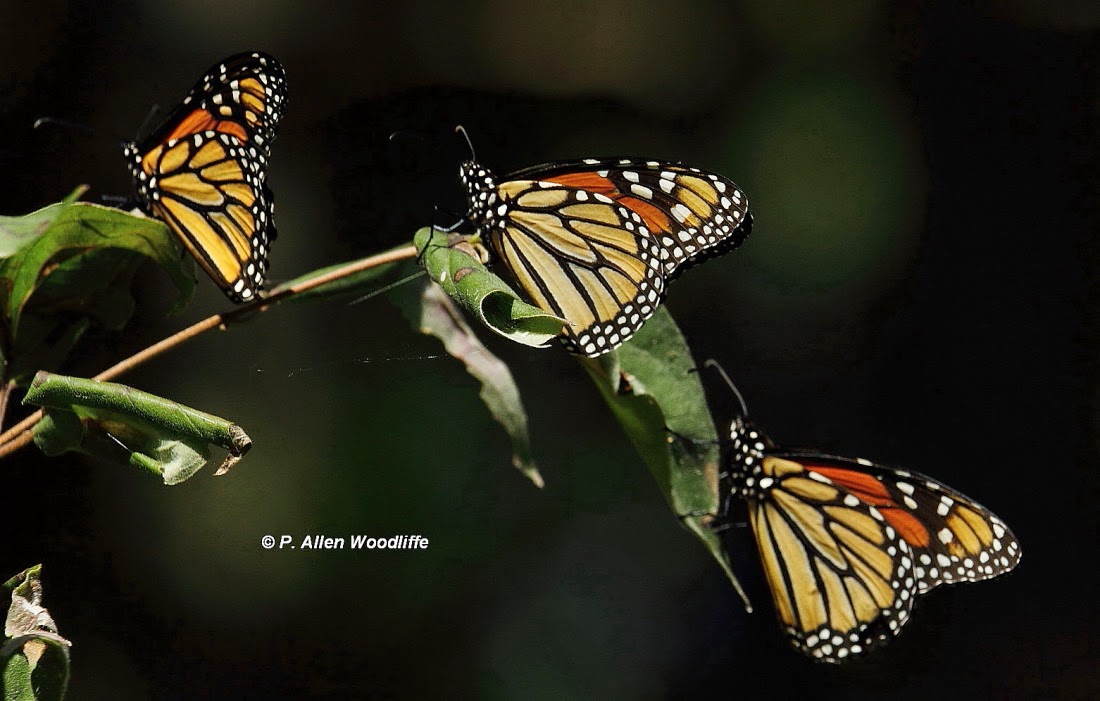It wasn't that many years ago that some huge numbers were recorded from some of these points. I have read of astounding numbers, such as half a million butterflies, leaving Point Pelee and heading across the lake on a northerly wind in a matter of hours.
What do bison, Passenger Pigeons and Monarchs have in common? A serious and in some cases, fatal, loss of numbers.
Sadly it appears that we may never see those numbers of butterflies again. Think about the many millions of bison that formerly roamed the mid-western parts of the continent. Or the billions of Passenger Pigeons that at times darkened the skies as they passed overhead. The bison population was salvaged from complete annihilation, and remains in protected areas across parts of the mid-west. Several state/provincial and national parks and private agencies have various sized herds they manage.
This first image depicts part of the ~2500 bison herd that roam freely across part of the almost 30,000 acre (12,100 ha) Tallgrass Prairie Preserve in northeastern Oklahoma, owned by The Nature Conservancy.
The next two images feature bison from Prairie State Park, where a herd of about 130 bison occur within this almost 4,000 acres (1,600 ha) park in southwestern Missouri.
The Passenger Pigeon is, as you undoubtedly are aware, extinct and at the beginning of this month we unfortunately marked the 100th anniversary of when the last known Passenger Pigeon died, in the Cincinnati Zoo. (No, I'm not quite old enough to have acquired any personal photos of Passenger Pigeon.)
While the two examples mentioned here don't necessarily seem to fit with the situation of the Monarch, the comparison is eerily relevant. Monarchs were present by the countless millions not that long ago. A National Geographic magazine of the 1970s described them as so numerous on their wintering grounds, that branches of the trees where they were roosting would break under the cumulative weight!
 |
| Part of a small Monarch roost at Rondeau a few years ago |
However in the last several decades, the effects of loss of wintering habitat in Mexico, combined with chemical sprays and the efficient eradication of milkweeds here in North America, have brought the population perilously low. In 2013, the numbers in Ontario at least, were probably as low as they have ever been since the glaciers left! It was almost a novelty to see a Monarch last year. And the Monarch Migration Festival at Point Pelee NP, where just a few years ago hundreds of thousands of butterflies could occasionally be seen in a single day, was cancelled due to the lack of butterflies.
The current year has not seemed quite as dismal. One can normally see at least a few Monarchs on outings to natural areas. I have noted more than a dozen caterpillars on milkweeds in my yard. The Hawkwatch sites at Hawk Cliff, Holiday Beach and Detroit River Metropark, record Monarch movements just like they do hawks, and sometimes several hundred are seen in one day. With milkweeds being removed from the noxious weed list, people are planting milkweed now, instead of being charged for not removing them from their property.
This coming Sunday, September 21, there is a Monarch Migration Festival going on at Rondeau Provincial Park. From the park's web site:
"Come out to Rondeau and join us for the day to send off our Monarch Butterflies as they migrate down to Mexico for the winter season! Activities include Monarch Tagging demonstrations, guided hikes, native plant sale and local artisan fair among much more! Stick around for lunch as the Friends of Rondeau will be BBQing up a storm from 11-2:30pm!"
This festival starts at 10:00 a.m. and goes until 4:00 p.m.
 |
| Banded Monarch |
So whatever your weekend activities entail, whether it is visiting one of the aforementioned Hawk Watch sites to join in with the activities and hawk watching opportunities there, keep in mind the plight of the Monarch and wherever you see one, take time to reflect and enjoy part of this dainty yet resilient critter's migration!






An excellent blog entry, Allen. I really enjoyed it. We've had well over a thousand monarchs go through here at home during the past 3 days. More than I've seen the past couple of years. Maybe a bit of a bounce-back but, as you state, we will probably never see things return to the days of old.
ReplyDeleteThanks, Steve. Glad to know that so many are in view from your place....you have a great location to enjoy such numbers.
DeleteAllen, do you know if anything is being done to protect the area of Mexico where monarchs winter?
ReplyDeleteThanks for the question. There are local and even national efforts to protect the wintering site. However the forested area has been very important for the local people who use the trees for fuel, etc. Therefore is a constant nibbling away of the forest resources, and unless there is a constant presence by personnel to keep watch, this constant nibbling away is slowly eroding the size and security of the site.
DeleteI definitely notice a difference in numbers between this year and last.
ReplyDeleteThe other evening at Point Pelee, at least 1000 were roosting in the trees on the east side of the Tip.
HI Karen....glad to know that numbers at Point Pelee are much improved over 2013.
Delete